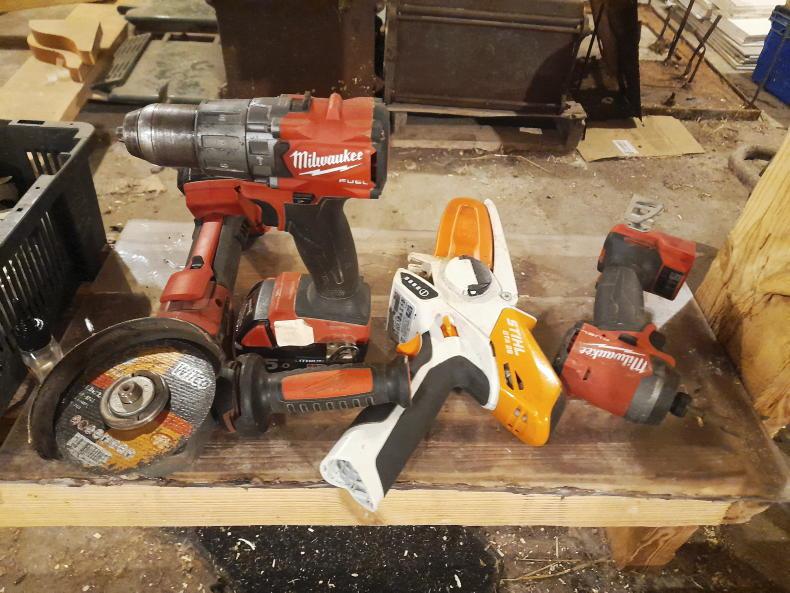Let me tell you a story about Vinnie. Vinnie had a problem. When he went to hook his plough to the tractor, he realised that the beam was broken.
As the weather was due to break the following Monday, Vinny knew that he really needed to get his ploughing done before then.
He had seen his neighbour Seanie out ploughing with a brand-new plough the previous week, so figuring that he would have finished with it by now, Vinnie thought that maybe Seanie wouldn’t mind him borrowing it for a few days.
“It is an emergency, after all,” he thought. So, without giving it a second thought, he hopped into his tractor to drive over to Seanie’s place.
Whilst he was driving along the lane, his mind started to wander a bit. As it did, another thought came to Vinny.
“Maybe Seanie hasn’t finished with it at all, so he’ll still need it? Mmmm,” he thought, “maybe I need to think this through a little bit more.
“If I ask him, it might be very awkward. Also, it’s a brand-new plough. He might be worried that I’ll break it. He might even feel obliged to give it to me, and knowing Seanie, he could just make up an excuse so that doesn’t have to give it to me.”
The more he thought about this, the more Vinnie figured that Seanie could make it really awkward for him.
“Jeez,” Vinnie thought, “It’s only a bloody plough, and this is a real emergency. He knows that if I don’t get my ploughing done before the weather breaks, it could ruin my whole season. And he knows right well where that will leave me.”
Vinny could feel the resentment building as he arrived at Seanie’s farm. He remembered a time when they were both kids, that Seanie had been particularly mean to him.
As he opened the gate to go into the yard, he couldn’t but see how neat and tidy Seanie had everything.
“Look at that,” he fumed, “that louser would put keeping his yard tidy over my family’s welfare. He knows that if I can’t use his plough, I’ll go to wrack and ruin. He’d be willing to let that happen, just so he can keep his bloody plough clean.
“That bugger will allow me stand there and beg him to let me use it. And then will make me feel small by saying no.”
Vinnie walked into the yard. As Seanie saw his old friend, he smiled: “Ah, how’re you doing Vinnie? It’s lovely to see you. How can I help?” he asked.
At this Vinny’s eyes bulged indignantly.
“Help,” he spat. “I’ll tell you how you can help, you can take that bloody plough of yours and shove it up your proverbial!”
Sound familiar? If we are to be honest with ourselves, a lot of us would identify with Vinnie more than we would like to admit. And if you have already said to yourself that you don’t, then think of the last time you lost a few hours because you were lost in your thinking.
Your head jumping from one topic to another, feeling anxious about nothing and everything.
Learning to recognise where our thinking is wrong, when we are absolutely convinced that we are right is a real skill that very few of us are good at. Overcoming our own self-deception and self-delusion involves recognising that when we are anxious, we are not trying to find the truth, we are trying to convince ourselves that we want to believe, is the truth.
So, overcoming anxiety doesn’t start with being willing to accept that our thinking is wrong. The journey starts by becoming willing, to be willing.
The vicious cycle
As we go through our day, our brains are constantly trying to understand our world, analysing what’s happening in our lives and figuring out how we should react to it.
Notice the conversation that goes on in your head the next time you are on your own. This’ internal dialogue’ is your emotional and logical minds talking to each other.
Because we’d drive ourselves nuts if we tried to analyse everything that happens in our day, our brains take short cuts. We get a thought about a situation and jump to conclusions as to what we think that situation means to us.
This conclusion (or as we call it, our belief) then triggers our emotion, which in turn triggers our behaviour to respond to the situation.
A simple way of illustrating this is to imagine someone standing in front of you with a knife. Your interpretation is that they are going to hurt you. This triggers your feeling of panic which makes you run away to save yourself.
When we are in a good space in our head, these continuous chain reactions don’t do us too much harm and we are reasonably able to balance what our brains are telling us.
However, if we are under a lot of stress, our emotional brain takes over. The more potential dangers we see in our world, the more stressed we become. As a result, our brains start scanning more and more. The more it scans, the more it sees, the more it sees, the more potential dangers it identifies. Hence the more anxious we get.
We then try to achieve the impossible, by trying to control things that we have no control over. The more control we try to be in, the more anxious we get.
Finding the willingness to change
When you click something on the web, Google recognises what you’ve engaged with. It then responds by sending you more of the same. The more you click, the more Google sends you.
Our brains work in the same way. The more we engage with certain thoughts, the more thoughts our brain sends us. By analysing and thinking about them, the more thoughts we are given to analyse.
To resolve our anxiety, we need to stop engaging with our unhealthy thoughts. Which means that we have to give our brains something else to engage with.
The world doesn’t need another self-help book to show us how to do this. God knows there are enough of them out there. What most of us need is to understand why these books don’t work for us.
Getting stuck in our washing machine head has more to do with our unwillingness to change our unhealthy behaviour than it does not knowing what to do. None of us will give up our irrational behaviours as long as there is any chance that we can make them work for us.
Similarly, any solution we choose, will be more to help us feel better rather than get better. No one becomes willing to change until they can see that what they think is their solution is actually what’s causing their problem.
We cannot think our way into right living, but we can act our way into right thinking. And to do that, we have to become willing to change our habits.
However, before we can ever become willing, we need to find the willingness to be willing.
Enda Murphy is a cognitive behavioural therapist and director of Seeme. For more details go to www.seeme.ie. Please email your own queries for Enda to advice@farmersjournal.ie
Read more
Mental Health: overcoming gut-wrenching anxiety
Do you really need friends? Yes but who they are depends on gender, age and need
Let me tell you a story about Vinnie. Vinnie had a problem. When he went to hook his plough to the tractor, he realised that the beam was broken.
As the weather was due to break the following Monday, Vinny knew that he really needed to get his ploughing done before then.
He had seen his neighbour Seanie out ploughing with a brand-new plough the previous week, so figuring that he would have finished with it by now, Vinnie thought that maybe Seanie wouldn’t mind him borrowing it for a few days.
“It is an emergency, after all,” he thought. So, without giving it a second thought, he hopped into his tractor to drive over to Seanie’s place.
Whilst he was driving along the lane, his mind started to wander a bit. As it did, another thought came to Vinny.
“Maybe Seanie hasn’t finished with it at all, so he’ll still need it? Mmmm,” he thought, “maybe I need to think this through a little bit more.
“If I ask him, it might be very awkward. Also, it’s a brand-new plough. He might be worried that I’ll break it. He might even feel obliged to give it to me, and knowing Seanie, he could just make up an excuse so that doesn’t have to give it to me.”
The more he thought about this, the more Vinnie figured that Seanie could make it really awkward for him.
“Jeez,” Vinnie thought, “It’s only a bloody plough, and this is a real emergency. He knows that if I don’t get my ploughing done before the weather breaks, it could ruin my whole season. And he knows right well where that will leave me.”
Vinny could feel the resentment building as he arrived at Seanie’s farm. He remembered a time when they were both kids, that Seanie had been particularly mean to him.
As he opened the gate to go into the yard, he couldn’t but see how neat and tidy Seanie had everything.
“Look at that,” he fumed, “that louser would put keeping his yard tidy over my family’s welfare. He knows that if I can’t use his plough, I’ll go to wrack and ruin. He’d be willing to let that happen, just so he can keep his bloody plough clean.
“That bugger will allow me stand there and beg him to let me use it. And then will make me feel small by saying no.”
Vinnie walked into the yard. As Seanie saw his old friend, he smiled: “Ah, how’re you doing Vinnie? It’s lovely to see you. How can I help?” he asked.
At this Vinny’s eyes bulged indignantly.
“Help,” he spat. “I’ll tell you how you can help, you can take that bloody plough of yours and shove it up your proverbial!”
Sound familiar? If we are to be honest with ourselves, a lot of us would identify with Vinnie more than we would like to admit. And if you have already said to yourself that you don’t, then think of the last time you lost a few hours because you were lost in your thinking.
Your head jumping from one topic to another, feeling anxious about nothing and everything.
Learning to recognise where our thinking is wrong, when we are absolutely convinced that we are right is a real skill that very few of us are good at. Overcoming our own self-deception and self-delusion involves recognising that when we are anxious, we are not trying to find the truth, we are trying to convince ourselves that we want to believe, is the truth.
So, overcoming anxiety doesn’t start with being willing to accept that our thinking is wrong. The journey starts by becoming willing, to be willing.
The vicious cycle
As we go through our day, our brains are constantly trying to understand our world, analysing what’s happening in our lives and figuring out how we should react to it.
Notice the conversation that goes on in your head the next time you are on your own. This’ internal dialogue’ is your emotional and logical minds talking to each other.
Because we’d drive ourselves nuts if we tried to analyse everything that happens in our day, our brains take short cuts. We get a thought about a situation and jump to conclusions as to what we think that situation means to us.
This conclusion (or as we call it, our belief) then triggers our emotion, which in turn triggers our behaviour to respond to the situation.
A simple way of illustrating this is to imagine someone standing in front of you with a knife. Your interpretation is that they are going to hurt you. This triggers your feeling of panic which makes you run away to save yourself.
When we are in a good space in our head, these continuous chain reactions don’t do us too much harm and we are reasonably able to balance what our brains are telling us.
However, if we are under a lot of stress, our emotional brain takes over. The more potential dangers we see in our world, the more stressed we become. As a result, our brains start scanning more and more. The more it scans, the more it sees, the more it sees, the more potential dangers it identifies. Hence the more anxious we get.
We then try to achieve the impossible, by trying to control things that we have no control over. The more control we try to be in, the more anxious we get.
Finding the willingness to change
When you click something on the web, Google recognises what you’ve engaged with. It then responds by sending you more of the same. The more you click, the more Google sends you.
Our brains work in the same way. The more we engage with certain thoughts, the more thoughts our brain sends us. By analysing and thinking about them, the more thoughts we are given to analyse.
To resolve our anxiety, we need to stop engaging with our unhealthy thoughts. Which means that we have to give our brains something else to engage with.
The world doesn’t need another self-help book to show us how to do this. God knows there are enough of them out there. What most of us need is to understand why these books don’t work for us.
Getting stuck in our washing machine head has more to do with our unwillingness to change our unhealthy behaviour than it does not knowing what to do. None of us will give up our irrational behaviours as long as there is any chance that we can make them work for us.
Similarly, any solution we choose, will be more to help us feel better rather than get better. No one becomes willing to change until they can see that what they think is their solution is actually what’s causing their problem.
We cannot think our way into right living, but we can act our way into right thinking. And to do that, we have to become willing to change our habits.
However, before we can ever become willing, we need to find the willingness to be willing.
Enda Murphy is a cognitive behavioural therapist and director of Seeme. For more details go to www.seeme.ie. Please email your own queries for Enda to advice@farmersjournal.ie
Read more
Mental Health: overcoming gut-wrenching anxiety
Do you really need friends? Yes but who they are depends on gender, age and need









SHARING OPTIONS